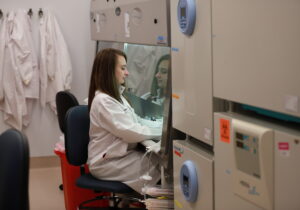Leadership from Behind a Screen
In a matter of minutes my entire research team went from ‘must work on campus to ‘non essential, send them home to work remotely.’ I found myself thinking this morning, am I the only one that has to figure out a way to actively lead my team from behind a screen?
I think academia may be one of the last industries that still over utilizes on-campus space compared to other industries. Call me old, or a dinosaur, or even closed minded (but those are definitely fighting words), but I enjoy engaging with my team, knowing how their day is going, what challenges they are having, sharing a meal, coffee, a walk, whatever the situation may be. I believe it’s relationships that truly help inspire and cultivate team dynamics and team success. I have been intentional about our video team meetings from when they happen, how long they happen, to what the agenda is. I found that Monday morning 9-9:30 and Friday afternoon 3-3:30 is working great. I found that starting off engaging in a little social conversation helps. Sometimes I reach out ahead of time to someone from my team and ask them to bring a question to pose to the rest of the team. Sometimes I read a funny post, and sometimes I just talk about the most recent rant that my 3 1/2 year old had. Anything to get the team engaged and talking before we get to business. I have found that keeping things to the point once the business starts is effective; they also feel their time is well spent and valued. Touching base throughout the week and showing appreciation for the work they continue to do is another way I am actively leading and I hope its making a difference.
So… anyone else trying to figure out how to actively lead from behind a screen? If so, what have you learned and/or what are you doing? Let’s share ideas.






3 Comments
The Edge for Scholars team is finding Slack highly adaptable as a platform to support a similar blend of organizational, personal, and lighter content a terrific tool. As you note, predictable contact is also key. We’re having daily huddles for 30 minutes and our typical longer weekly meeting, strongly encouraged to be by video conference complete with children, pets, partners, and messy houses in order to “see” each other. Not a substitute for walking by each others desks and sidebar chats in the hall but we’re adapting to ways to use Slack for those quick contacts.
Slack is also something we like, but this was a communication forum my team (composed of millenials) used a lot even before the hard left we all just took. I started a COVID19 channel so our regular channels weren’t filled with that (work-related) information, as I know we all need breaks from that chatter. I like your point about building in time for social conversation. Many of us are using Zoom for work meetings now, but I’m also considering using it as a platform to replace the social gatherings I used to host to promote team cohesiveness. True, it’s not the same as sitting and eating pizza together, but with a little creativity, I’m sure there are ways to provide opportunities that recapture some of that essence. Now would be a good time to embrace the scientific Twitter community too, here’s an EFS blog post on how: https://edgeforscholars.org/professional-success-in-social-media/.
I agree with having intentional video team meetings. As someone who likes structure, I like knowing that the first 10-15 minutes of our weekly meetings are for a social check-in, especially with the COVID pandemic occurring. A great leader needs to understand the pulse of the team, and how to help a member who may be struggling mentally or emotionally. The next 30-45 minutes are reserved for agenda items that have been sent out prior to the meeting, and it “almost” replicates our face-to-fact interactions at the bench. While software like Zoom is relatively new, it gives me confidence in our leader when he uses it, tries new features (e.g. share screen, background changes, retouching of the video, etc.), and have us lead meetings using Zoom as well.
The idea of video conferencing isn’t new, but I think we’re living in a time when the technology has finally caught up with the idea of instantaneous, easy communication online. No longer are our videos pixelated and laggy with a disconnect between video and audio. Perhaps this will signal a new era of weekly (or bi-weekly) lab meetings that allow for greater connectivity and communication among lab members.